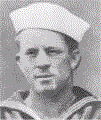 |
83k | Osmond K. Ingram, GM1c, USN. Awarded the Medal of Honor for heroism during the torpedoing of the USS Cassin (DD-43) October 15 1917. He lost his life during this action and was the first enlisted man to have a Destroyer named in his honor. Naval Historical Center photo NH91637.
Medal of Honor citation of Gunner's Mate First Class Osmond K. Ingram: "For extraordinary heroism in the presence of the enemy on the occasion of the torpedoing of the Cassin (DD-43) on 15 October 1917. While the Cassin was searching for the submarine, Ingram sighted the incoming torpedo coming, and realizing that it might strike the ship aft in the vicinity of the depth charges, ran aft with the intention of releasing the depth charges before the torpedo could reach the Cassin. The torpedo struck the ship before he could accomplish his purpose and Ingram was killed by the explosion. The depth charges exploded immediately afterward. His life was sacrificed in an attempt to save the ship and his shipmates, as the damage to the ship would have been much less if he had been able to release the depth charges." | Daniel Dunham/Bill Gonyo |
 |
115k | Painting of sailor Osmund K. Ingram, as he makes a gallant effort to release the ship's depth charges moments before a torpedo strikes the destroyer USS Cassin. Ingram was blown overboard, and became the first Navy man to be killed in World War I, and was awarded the Medal of Honor posthumously. Courtesy of the Library of Congress. Taken from "An Illustrated History of the United States Navy" by Chester G. Hearn. | Robert Hurst/Tommy Trampp |
THE SECRETARY OF THE NAVY
WASHINGTON
The President of the United States takes pleasure in presenting the PRESIDENTIAL UNIT CITATION to the
UNITED STATES SHIP BOGUE
with her Embarked Planes and Escort Vessels constituting the Five Task Groups listed below for service as set forth in the following
Citation:
"For outstanding performance in combat against enemy submarines in the Atlantic Area from April 20, 1943, to July 3, 1944. Carrying out powerful and sustained offensive action during a period of heavy German undersea concentrations threatening our uninterrupted flow of supplies to the European Theater of operations, the U.S.S. BOGUE, her embarked planes and her escorts tracked the enemy packs relentlessly and, by unwavering vigilance, persistent aggressiveness and perfect cooperation of all units involved, sank a notable number of hostile U-boats. The superb leadership of the BOGUE and the gallant spirit of the officers and men who fought her planes and manned her escort vessels were largely instrumental in forcing the complete withdrawal of enemy submarines from supply routes essential to the maintenance of our established military supremacy."
United States Ships Bogue, Lea, Greene, Belknap, Osmond Ingram, George E. Badger, and VC-9 from April 20 to June 20, 1943.
United States Ships Bogue, Osmond Ingram, George E. Badger, Clemson, and VC-9 from July 12 to August 23, 1943.
United States Ships Bogue, Osmond Ingram, George E. Badger, Clemson, Dupont and VC-19 from November 14 to December 29, 1943.
United States Ships Bogue, Haverfield, Swenning, Willis, Hobson (until March 25), Janssen (until April 7) and VC-95 from February 26 to April 19, 1944.
United States Ships Bogue, Haverfield, Swenning, Willis, Janssen, F. W. Robinson, and VC-69 from May 4 to July 3, 1944.
For the President,
James Forrestal
Secretary of the Navy |


